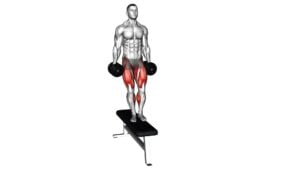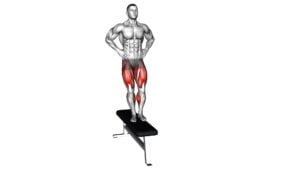Kettlebell Lateral Step-up (male) – Video Exercise Guide & Tips

In this video exercise guide, you'll learn all about the kettlebell lateral step-up.
Watch This Exercise Video
This exercise is great for targeting your lower body muscles and improving your stability and balance.
Watch the video to see proper form and technique, and discover tips for choosing the right kettlebell weight and progressing your workouts.
Maximize your results with expert advice and get ready to take your workout to the next level.
Let's get started!
Key Takeaways
- Targets lower body muscles
- Improves stability and balance
- Strengthens core muscles
- Can be modified for different fitness levels
Benefits of Kettlebell Lateral Step-up
Experience enhanced strength and stability in your lower body by incorporating the kettlebell lateral step-up into your workout routine. This exercise is an effective way to improve balance and increase lower body strength.
The kettlebell lateral step-up targets the muscles in your legs, including the quadriceps, hamstrings, and glutes. By performing this exercise, you're actively engaging these muscles, which helps to build strength and power. As you step up onto the box or platform with one leg, you're also challenging your balance and stability. This is important for everyday activities and sports that require coordination and control.
In addition to improving balance and increasing lower body strength, the kettlebell lateral step-up also benefits your core muscles. As you lift the kettlebell, you engage your core to maintain stability and control. This exercise can help to strengthen your abs, obliques, and lower back muscles.
To perform the kettlebell lateral step-up, start by standing beside a box or platform with a kettlebell in one hand. Step up onto the box with your outside leg, driving through your heel and keeping your core engaged. Lower yourself back down and repeat on the other side. Remember to maintain proper form and control throughout the exercise.
Incorporating the kettlebell lateral step-up into your workout routine won't only improve your balance but also increase your lower body strength. This exercise is a versatile addition to any training program and can be modified to suit your fitness level.
Proper Form and Technique
To perform the kettlebell lateral step-up correctly, stand beside a box or platform with a kettlebell in one hand. Start by placing your foot on top of the box, ensuring that your knee is aligned with your ankle. Push through your heel and lift your body up onto the box, extending your hip and knee. Maintain a neutral spine throughout the movement and engage your core for stability.
One common mistake to avoid is using momentum to lift your body onto the box. This can put unnecessary strain on your joints and increase the risk of injury. Instead, focus on using controlled movements and relying on the strength of your leg muscles.
Another mistake to watch out for is letting your knee collapse inward as you lift your body. This can cause stress on the knee joint and increase the risk of injury. Make sure to keep your knee in line with your ankle throughout the exercise.
To prevent injury, it's important to warm up before attempting the kettlebell lateral step-up. This will help to prepare your muscles and joints for the exercise. Additionally, start with a lighter weight kettlebell and gradually increase the load as you become more comfortable with the movement.
Choosing the Right Kettlebell Weight
When choosing the right kettlebell weight, consider your current fitness level and select a weight that challenges you without compromising proper form. It's important to find the right balance between pushing yourself and maintaining good technique to prevent injury.
One of the most common mistakes people make is choosing a weight that's too heavy, leading to improper form and increased risk of strain or injury. On the other hand, selecting a weight that's too light won't provide enough resistance to effectively work your muscles.
To ensure your safety, start with a lighter weight and gradually increase as you become more comfortable and confident in your technique. It's also a good idea to consult with a fitness professional who can assess your current fitness level and provide guidance on the appropriate weight for you. Keep in mind that safety should always be a priority when choosing a kettlebell weight.
Transitioning into the next section about variations and progressions, once you have mastered the correct weight for your current fitness level, you can start exploring different kettlebell exercises and gradually progress to heavier weights to continue challenging your body and achieving your fitness goals.
Variations and Progressions
Once you have mastered the correct weight for your current fitness level, you can explore different variations and progressions of kettlebell exercises to continue challenging yourself and achieving your fitness goals.
To take your kettlebell workouts to the next level, you can try advanced modifications of the kettlebell lateral step-up exercise. One variation is to increase the weight of the kettlebell you're using. This will add more resistance and make the exercise more challenging for your muscles.
Another way to progress is to increase the height of the step or platform you're stepping onto. This will require more strength and stability from your legs and core muscles. You can also try adding a knee raise at the top of the movement to further engage your abs and hip flexors.
When attempting advanced modifications, it's important to maintain proper form and technique. One common mistake is using too much weight, which can lead to loss of control and increased risk of injury. Another mistake isn't fully extending your hips and knees at the top of the movement, which reduces the effectiveness of the exercise.
Remember to always listen to your body and progress at a pace that feels challenging but manageable. By incorporating advanced modifications and avoiding common mistakes, you can continue to improve your strength, stability, and overall fitness with kettlebell exercises.
Tips for Maximizing Results
To get the most out of your kettlebell lateral step-up exercise and maximize your results, focus on maintaining proper form and technique throughout the movement. Here are some tips for improving your technique and avoiding common mistakes:
- Engage your core: Keep your abdominal muscles tight throughout the exercise to stabilize your body and maintain balance.
- Control your movements: Avoid using momentum to lift your leg and instead focus on controlled and deliberate movements.
- Keep your chest up: Maintain an upright posture throughout the exercise to engage your core and prevent strain on your lower back.
By following these tips, you can ensure that you're performing the kettlebell lateral step-up exercise correctly and effectively. This will help you target the desired muscle groups and prevent injuries.
Common mistakes to avoid include:
- Leaning forward: Keep your torso upright and avoid leaning forward as this can put unnecessary strain on your lower back.
- Using too much weight: Start with a lighter kettlebell and gradually increase the weight as you become more comfortable with the exercise.
- Neglecting proper form: Focus on maintaining proper form throughout the movement, even if it means using a lighter weight. This will help you avoid injuries and maximize your results.
Frequently Asked Questions
How Many Calories Can Be Burned by Doing the Kettlebell Lateral Step-Up Exercise?
When you do the kettlebell lateral step-up exercise, you can burn a significant amount of calories. This exercise is a great way to engage multiple muscle groups and increase your heart rate, leading to increased calorie burn.
Additionally, you can vary the intensity of the exercise by adjusting the weight of the kettlebell or incorporating other variations and progressions.
Is the Kettlebell Lateral Step-Up Suitable for Beginners?
The kettlebell lateral step-up exercise can be suitable for beginners. It's a great way to build strength, stability, and balance in your lower body.
By performing variations of the kettlebell lateral step-up, you can target different muscles and challenge yourself as you progress. Benefits of this exercise include improving leg strength, increasing hip mobility, and enhancing overall athletic performance.
Make sure to start with lighter weights and focus on proper form to avoid injury.
Can the Kettlebell Lateral Step-Up Help Improve Balance and Stability?
The kettlebell lateral step-up can definitely help improve your balance and stability. By incorporating this exercise into your routine, you'll be enhancing your proprioception, which is your body's ability to sense its position in space.
This exercise requires coordination and control as you step onto the elevated platform with the kettlebell in hand. Practicing it regularly will strengthen your lower body and core muscles, ultimately improving your overall balance and stability.
What Muscles Are Primarily Targeted During the Kettlebell Lateral Step-Up?
During the kettlebell lateral step-up, several muscles are primarily targeted. The key benefits of this exercise include improving lower body strength, stability, and balance. The muscles that are mainly worked during this exercise are the quadriceps, glutes, hamstrings, and hip abductors.
Proper form and technique are crucial for maximizing the effectiveness of this exercise. Make sure to maintain a stable core, step onto the platform with control, and engage the targeted muscles throughout the movement.
Can the Kettlebell Lateral Step-Up Be Modified for Individuals With Knee or Hip Issues?
If you have knee or hip issues, you may need to modify the kettlebell lateral step-up exercise. There are alternatives that are more joint friendly and can still help you target the same muscles.
It's important to prioritize your safety and comfort during workouts. Consider using a lower step height or replacing the kettlebell with a lighter weight or resistance band.
Always consult with a fitness professional or physical therapist for personalized modifications.
Conclusion
In conclusion, the kettlebell lateral step-up is a highly effective exercise that offers numerous benefits, including improved lower body strength, stability, and balance.
By ensuring proper form and technique, selecting the appropriate kettlebell weight, and exploring variations and progressions, you can maximize your results.
Incorporating these tips into your workout routine will help you achieve your fitness goals efficiently and effectively.

Author
Years ago, the spark of my life’s passion ignited in my mind the moment I stepped into the local gym for the first time. The inaugural bead of perspiration, the initial endeavor, the very first surge of endorphins, and a sense of pride that washed over me post-workout marked the beginning of my deep-seated interest in strength sports, fitness, and sports nutrition. This very curiosity blossomed rapidly into a profound fascination, propelling me to earn a Master’s degree in Physical Education from the Academy of Physical Education in Krakow, followed by a Sports Manager diploma from the Jagiellonian University. My journey of growth led me to gain more specialized qualifications, such as being a certified personal trainer with a focus on sports dietetics, a lifeguard, and an instructor for wellness and corrective gymnastics. Theoretical knowledge paired seamlessly with practical experience, reinforcing my belief that the transformation of individuals under my guidance was also a reflection of my personal growth. This belief holds true even today. Each day, I strive to push the boundaries and explore new realms. These realms gently elevate me to greater heights. The unique combination of passion for my field and the continuous quest for growth fuels my drive to break new ground.







